The endocytic protein GRAF1 is directed to cell-matrix adhesion sites and regulates cell spreading
- PMID: 21965292
- PMCID: PMC3216663
- DOI: 10.1091/mbc.E10-12-0936
The endocytic protein GRAF1 is directed to cell-matrix adhesion sites and regulates cell spreading
Abstract
The rho GTPase-activating protein GTPase regulator associated with focal adhesion kinase-1 (GRAF1) remodels membranes into tubulovesicular clathrin-independent carriers (CLICs) mediating lipid-anchored receptor endocytosis. However, the cell biological functions of this highly prevalent endocytic pathway are unclear. In this article, we present biochemical and cell biological evidence that GRAF1 interacted with a network of endocytic and adhesion proteins and was found enriched at podosome-like adhesions and src-induced podosomes. We further demonstrate that these sites comprise microdomains of highly ordered lipid enriched in GRAF1 endocytic cargo. GRAF1 activity was upregulated in spreading cells and uptake via CLICs was concentrated at the leading edge of migrating cells. Depletion of GRAF1, which inhibits CLIC generation, resulted in profound defects in cell spreading and migration. We propose that GRAF1 remodels membrane microdomains at adhesion sites into endocytic carriers, facilitating membrane turnover during cell morphological changes.
Figures
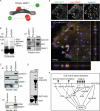
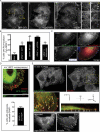
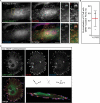
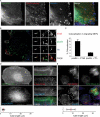
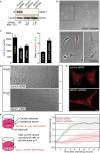
Similar articles
-
Endocytosis of gene delivery vectors: from clathrin-dependent to lipid raft-mediated endocytosis.Mol Ther. 2013 Jun;21(6):1118-30. doi: 10.1038/mt.2013.54. Epub 2013 Apr 16. Mol Ther. 2013. PMID: 23587924 Free PMC article. Review.
-
GRAF1-dependent endocytosis.Biochem Soc Trans. 2009 Oct;37(Pt 5):1061-5. doi: 10.1042/BST0371061. Biochem Soc Trans. 2009. PMID: 19754452 Review.
-
The GTPase-activating protein GRAF1 regulates the CLIC/GEEC endocytic pathway.Curr Biol. 2008 Nov 25;18(22):1802-8. doi: 10.1016/j.cub.2008.10.044. Curr Biol. 2008. PMID: 19036340 Free PMC article.
-
Endocytic membrane turnover at the leading edge is driven by a transient interaction between Cdc42 and GRAF1.J Cell Sci. 2015 Nov 15;128(22):4183-95. doi: 10.1242/jcs.174417. Epub 2015 Oct 7. J Cell Sci. 2015. PMID: 26446261 Free PMC article.
-
Endocytic turnover of Rab8 controls cell polarization.J Cell Sci. 2017 Mar 15;130(6):1147-1157. doi: 10.1242/jcs.195420. Epub 2017 Jan 30. J Cell Sci. 2017. PMID: 28137756 Free PMC article.
Cited by
-
Pyk2 Signaling through Graf1 and RhoA GTPase Is Required for Amyloid-β Oligomer-Triggered Synapse Loss.J Neurosci. 2019 Mar 6;39(10):1910-1929. doi: 10.1523/JNEUROSCI.2983-18.2018. Epub 2019 Jan 9. J Neurosci. 2019. PMID: 30626696 Free PMC article.
-
Follow-up to genome-wide linkage and admixture mapping studies implicates components of the extracellular matrix in susceptibility to and size of uterine fibroids.Fertil Steril. 2015 Feb;103(2):528-34.e13. doi: 10.1016/j.fertnstert.2014.10.025. Epub 2014 Nov 20. Fertil Steril. 2015. PMID: 25455875 Free PMC article. Clinical Trial.
-
Endocytosis of gene delivery vectors: from clathrin-dependent to lipid raft-mediated endocytosis.Mol Ther. 2013 Jun;21(6):1118-30. doi: 10.1038/mt.2013.54. Epub 2013 Apr 16. Mol Ther. 2013. PMID: 23587924 Free PMC article. Review.
-
The role of GTPase-activating protein ARHGAP26 in human cancers.Mol Cell Biochem. 2022 Jan;477(1):319-326. doi: 10.1007/s11010-021-04274-3. Epub 2021 Oct 30. Mol Cell Biochem. 2022. PMID: 34716859 Free PMC article. Review.
-
TGFB1 is secreted through an unconventional pathway dependent on the autophagic machinery and cytoskeletal regulators.Autophagy. 2018;14(3):465-486. doi: 10.1080/15548627.2017.1422850. Epub 2018 Mar 11. Autophagy. 2018. PMID: 29297744 Free PMC article.
References
-
- Block MR, Badowski C, Millon-Fremillon A, Bouvard D, Bouin AP, Faurobert E, Gerber-Scokaert D, Planus E, Albiges-Rizo C. Podosome-type adhesions and focal adhesions, so alike yet so different. Eur J Cell Biol. 2008;87:491–506. - PubMed
-
- Caswell PT, Vadrevu S, Norman JC. Integrins: masters and slaves of endocytic transport. Nat Rev Mol Cell Biol. 2009;10:843–853. - PubMed
-
- Chadda R, Howes MT, Plowman SJ, Hancock JF, Parton RG, Mayor S. Cholesterol-sensitive Cdc42 activation regulates actin polymerization for endocytosis via the GEEC pathway. Traffic. 2007;8:702–717. - PubMed
Publication types
MeSH terms
Substances
Grants and funding
LinkOut - more resources
Full Text Sources
Research Materials
Miscellaneous

